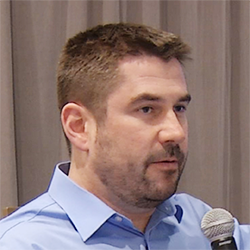In this video Dr. Singer discusses the Valsalva maneuver as a key element of autonomic function testing.
On to the Valsalva maneuver. We use the Valsalva maneuver really for two reasons: number one, to assess vagal function and for that part we look at heart rate, and then we will also look at it from the aspect of assessing adrenergic function and for that we look at the blood pressure response. So right now, we are talking mostly about the heart rate response still.
The way we perform the Valsalva maneuver, we start out in a supine position, we hook patients up to EKG and a beat-to-beat blood pressure device, and then let them rest. And they have already been resting during the QSART and the deep breathing, so they’ve already been supine for about half an hour before we start, but we give them an additional 3 minutes or so of quiet rest, and then have them blow into a bugle. A bugle with a little bit of an air leak to make sure the glottis is open, and we have them exhale and achieve an expiratory pressure of about 40 mmHg. And there are good studies that show the longer the better. Studies have shown that 20 seconds is actually desirable, but many people are not able to do that so for practical reasons we have standardized it to 15 seconds. We try to do the Valsalva maneuver as long as we get two reproducible responses. We usually limit ourselves to 4 or 5 because it is quite a strain, but usually after 4 attempts you get two reproducible ones that you’re happy with. There are certain circumstances when we go from a supine to a slightly tilted up position and we’ll demonstrate and talk about that more during the actual demonstration. And what we do is when we look at the Valsalva maneuver in terms of the heart rate response, we look at the highest heart rate during the maneuver and divide that by the lowest response following the maneuver and that is called the Valsalva ratio. This is basically how it’s derived.
Really when you look at the Valsalva maneuver, that heart rate response is the result of baroreflex function because it is triggered by the blood pressure response that proceeds it and therefore it is very, very important to not only look at the heart rate response but look at the blood pressure profile at the same time because there are variations to normal and those can influence your heart rate response to the maneuver. So, for example, someone who has a very exaggerated blood pressure fall, for example due to adrenergic failure, may have a normal Valsalva ratio but it is relatively abnormal considering the huge blood pressure drop that proceeded it. On the other hand, you may have a patient that has a response like the one indicated here on the bottom, a so-called flattop or square wave response. There the blood pressure drops, never below baseline, and so you do not have an adequate stimulus to really increase heart rate and so that heart rate response in this case is actually normal, but in many circumstances that might get blunted and its looks abnormal when you look at normal values but really it’s not abnormal considering the blood pressure profile. And so you really need both to make an adequate judgment as to what’s normal and abnormal.
Again, there are a number of factors that can affect the Valsalva ratio other than disease. Age and gender play a role here and of course there are other factors, and here’s a mechanical force that’s inducing maneuver, so the expiratory pressure is important. We shoot for 40, some people can’t get to 40 mmHg, then we are satisfied with 30, even 20 in some circumstances. A fragile old person or kid usually is not able to get much more than 20, we are fine with that. Once you go below that it becomes a little questionable if you really can assess the response. Similarly, the duration: 15 seconds is already a compromise, going less than 15 seconds…12 seconds is the absolute minimum I would consider an adequate Valsalva maneuver. If it’s less than that, there may not be enough time for late phase 2 to form for the adrenergic system to kick in and you may read the test as abnormal even though it is not. Medications again, very important – antihypertensives, alpha-blockers, beta-blockers clearly effect your Valsalva maneuver. Again, there are normative values. As you can see, age is a factor, gender as well. Again, those values are published and just for your information shown here on that table.
Again, a normal response on the top, you can see a nice tachycardia forming during the maneuver and then reflex bradycardia following the maneuver. This is a patient with radiation-induced baroreflex failure. You see a little bit of a mechanically induced bradycardia at first, but otherwise, there’s not whatsoever cardiac acceleration during the maneuver, no bradycardia following the maneuvers. It’s pretty virtually a Valsalva ratio of zero, actually 1, 1 is the lowest. Now I mentioned that Valsalva ratio really reflects baroreflex function to some degree. There’s a little more sophisticated ways to look at vagal baroreflex function with the Valsalva maneuver when we obtain it in the lab because we can basically relate the changes in heart rate that occur as a result of changes in blood pressure and we do that basically as we literally look at the linear relationship between the heart rate response and the preceding fall in blood pressure. We can do that both for early phase 2 shown here or for phase 4 of the Valsalva maneuver and derive that linear relationship, which is an index of vagal baroreflex function. It’s a little fancier than just looking at the Valsalva ratio. For the most part it’s sort of supplementary information. We don’t use that routinely in clinic, but we have that available for certain cases where it’s of interest.

Wolfgang Singer, MD
Associate Professor of Neurology
Mayo Clinic Rochester, MN































